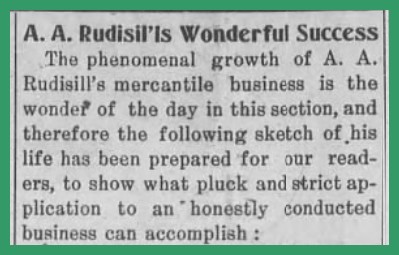In its October 12, 1906 edition, the Lykens Standard profiled merchant Albert A. Rudisill:
A. A. RUDISILL’S WONDERFUL SUCCESS
The phenomenal growth of A. A. Rudisill‘s mercantile business is the wonder of the day in this section, and therefore the following sketch of his life has been prepared for our readers, to show what pluck and strict application to an honestly conducted business can accomplish.
Mr. Rudisill was born in Lykens, May 6, 1868. When three years old, his parents, David Rudisill and wife, moved to Kalmia, where his father had secured the position of outside foreman at Kalmia Colliery under Phillips and Sheafer. At 12 years of age he returned to Lykens with his parents, his father and brother Adam having opened a cigar factory in a building on Main Street where Lebo’s tin store is now located, he going to school during the day and stripping tobacco leaves after school hours. When 15 years of age, tiring of school, he secured a position in Short Mountain Breaker under the late C. M. Moyer. One night in March, 1883, while working at the washery, he met with an accident which resulted in the loss of the sight of the right eye, and which terminated his labors at the mines. His next employment was as messenger boy under A. D. Hanna, the Pennsylvania Railroad telegraph operator at this place [Lykens] at that time, and learned telegraphy. After working nine months as messenger he secured a position with the National Transit Company as a telegraph operator, but after serving in this capacity for one year he was induced by his father to resign the position, who thought he was too young for its arduous duties at that time. He then opened a white goods and novelty store in the Hoffman building at Williamstown, but only remained there six months when he removed his store to the Red Front, on Main Street, this borough, at present occupied by C. M. Stein. The location did not suit him, however, and he closed out his business and again entered the employ of the National Transit Company, remaining with them this time for 11 years. His ambition still leaning toward mercantile pursuits, he returned to his birth place and purchased the Garman property, 304 North Second Street, where he opened up a small store in November, 1901. His business increasing, in 1902 he enlarged the store room and added a large ware house for storage purposes, but it was not long before he again was confronted with the necessity of more room, and built another addition to store and also enlarged the ware house, and added shoes and dry goods to his stock. So rapidly has his business grown that for the third time in the short period of six years he has been compelled to enlarge his quarters and is now building a two-story addition, 32×32, with basement, making, when completed, the largest and best equipped store room between Harrisburg and Pottsville. The first floor has nearly 2,500 square feet of floor space, the second 1,400 square feet, the basement and cellar 2,846 square feet, making a grand total of 6,746 square feet devoted to his business. one side of store room will have a stretch of 90 feet of glass floor show cases. The building will be lighted by a 75-light acetylene plant, making it a very attractive place for shopping.
Twenty-five years later [1931], Rudisill was found dead in a Philadelphia hotel room. About one year prior to his death, he suddenly disappeared from Lykens while rumors circulated that he was in financial difficulty.
See:
________________________________
News articles are from Newspapers.com.
Corrections and additional information should be added as comments to this post.
